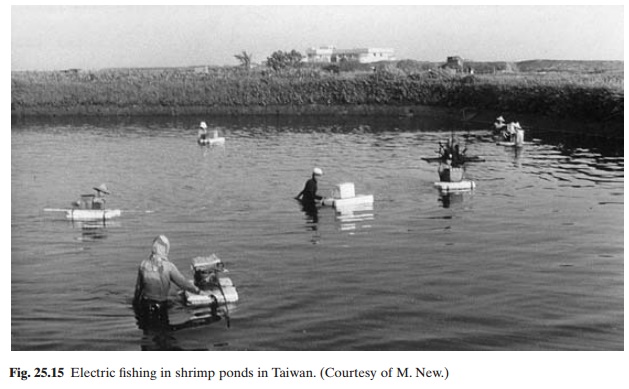Chapter: Aquaculture Principles and Practices: Shrimps and Prawns
Harvesting and marketing of shrimps
Harvesting and marketing
Methods of harvesting shrimps have been briefly described. Efficient
harvesting has to be based on the habits of the particular species under
culture and the culture procedures. Shrimps graze at night and are generally
attracted by light. They also respond actively to water movements, especially
when water is let into a pond or drained. Most Penaeid species are more active
during the full moon and new moon, and the maximum activities are shortly after
sunset and shortly before sunrise. These are the best times for harvest.
Total harvest is usually carried out at the end of each crop by draining
and placing a bag net at the sluice gate to catch the shrimps as they swim from
the pond. Partial harvesting can be done by seine nets after partial draining,
from peripheral canals or from harvest basins. Some farmers catch the shrimps
in large traps built in the outlet canals outside the sluice gates, as the pond
is drained. In Taiwan, cast nets are some-times employed for partial
harvesting, using sea snails as bait.
As mentioned, it is very profitable to sell shrimps alive in countries
like Japan, and so the harvesting technique has to be adapted for capturing
them without injury. The pound net used in Japan to trap shrimps is well-suited
for this purpose. During cool seasons, when the shrimps do not move so actively
at the bottom, a pump net or an electric shock is more effective (fig. 25.15).
These methods are suitable for P.
japonicus, which burrows at the bottom. Electric fishing is successfully
employed in harvesting tiger shrimps in Taiwan. Harvesting is avoided when most
of the shrimps are moulting, as soft-shelled shrimps will not stand handling.
Live shrimps are transferred to containers placed in cold water tanks. Methods
of packing and transport of live shrimps have been described.

Since shrimp culture in many developing countries is export-oriented,
modern methods of chilling, freezing and packing are practised to meet the
requirements and regulations of importing countries. Whole shrimps, shrimp
tails or partially or completely shelled products are exported.
Related Topics